
The Project Gutenberg EBook of Cigar-Box Dioramas, by Arminta Neal
This eBook is for the use of anyone anywhere in the United States and most
other parts of the world at no cost and with almost no restrictions
whatsoever. You may copy it, give it away or re-use it under the terms of
the Project Gutenberg License included with this eBook or online at
www.gutenberg.org. If you are not located in the United States, you'll have
to check the laws of the country where you are located before using this ebook.
Title: Cigar-Box Dioramas
A "How-to-do-it" Handbook
Author: Arminta Neal
Release Date: May 13, 2018 [EBook #57148]
Language: English
Character set encoding: UTF-8
*** START OF THIS PROJECT GUTENBERG EBOOK CIGAR-BOX DIORAMAS ***
Produced by Stephen Hutcheson and the Online Distributed
Proofreading Team at http://www.pgdp.net

A “How-to-do-it” Handbook
by
Arminta Neal
Sincere thanks are due Shirley Parman and Doris Samford for their assistance in this booklet’s preparation.
Copyright 1958 by Arminta Neal
Second Printing 1961
In addition, you are apt to need ...
The box can be designed with the lid to open up, down or to one side. The main label is pasted inside the lid.

The box is painted on the outside, either with any of the rubber-base (latex) paints, or with paint from a spray can. The inside of the box is given one or two coats of the black latex paint. (Other flat black paints may also be used.)
Be very sure to wash any brushes that are used with the latex paint very soon after use. Use warm water and bar soap (such as Ivory). Once the rubber-base paint hardens there is little that can be done to restore the bristles.
A piece of black construction paper is cut to fit the box interior in a curve from one side to the other. The magazine picture or large post-card you are using for the background is pasted to the construction paper, using Tri-Tix rubber cement. Then this curved paper is pasted to the box.

If it is desired, a foreground base can be made with a block of balsa wood or a piece of styrofoam plastic. The material is carved to blend, in surface contours, with the background picture. If the background picture has land with uneven contours, with hills or bluffs, it will be best to carve the block with a slope down away from the front of the box.

If the background picture shows a low, level, flat area, the foreground block should be carved sloping up at the back.

If a flat base is desired, Elmer’s glue is brushed on the bottom inside of the box and sand, gravel, dyed sawdust or other texture is sprinkled on the wet glue, after the figures are glued in place.
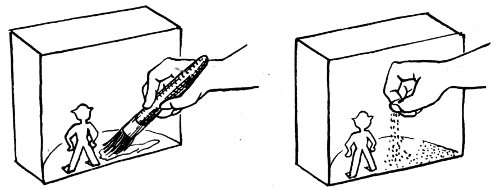
The foreground is made from cut-out pictures or from figures and accessories from hobby shops, ten-cent stores or other sources.
There are two methods of using magazine pictures for the foreground figures:
(1) Paste the pictures to index cards or cardboard of similar weight. Use Tri-Tix cement. Put the picture face down on scrap paper; brush or spread a thin but complete coat of Tri-Tix on the back of the picture. Work from the center out, in radiating strokes.

Turning the picture over, place the center of the picture down on the cardboard. Smooth down from the center out. Place piece of waxed or scrap paper over picture, roll down with a linoleum brayer or rolling pin. This helps to remove all air bubbles.

Let cement dry completely before trimming picture. When the excess rubber cement (squeezed out on the scrap paper) has changed from milky white to a translucent material, the cement on the picture will be dry. Cutting against the plate glass, trim out the parts of the picture needed with the X-Acto knife. Cutting against the glass produces a cleaner edge than against a different surface.
If your foreground is the flat side of the box, without carved balsa or styrofoam block, leave tabs on the bottoms of the trimmed figures. Fold these tabs back and glue to base.

If your foreground is of carved balsa or styrofoam, trim out figure completely, then glue supporting wire to the back. Straightened paper clips may be used, being glued down with Elmer’s glue. Let about ½″ of wire extend from bottom of figure. When glue is dry, force wire into base.
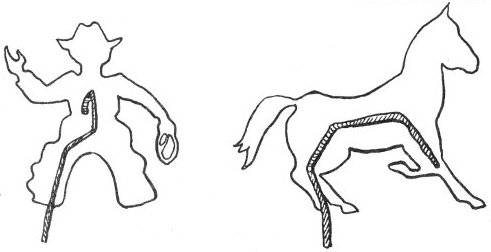
(2) The second method of using pictures is to glue the picture to a piece of light weight (tooling) aluminum or copper (about 32 oz. weight). Brush Pliobond on the back of the picture, smooth picture on aluminum or copper. Press out all air bubbles. The Pliobond holds immediately; there is no need to wait. Use scissors to cut out the picture. Manicure scissors will help in small areas. Narrow strips, such as the legs of animals, will curl, but the Pliobond will hold the paper tight, and the metal can be straightened. 5 Fold a rag or smooth-finish hand towel (not terry cloth) into a soft pad. Place trimmed picture face down on pad. Using a dental tool, rounded end of a nut pick, leather modelling tools or similar equipment, work the metal into a rounded form. Tool in the same manner as in regular copper work.
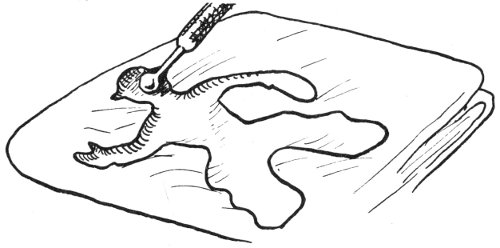
When completely tooled, the figure will have an appearance similar to that of bas-relief. Again, the figures are reinforced with wire glued to the back, using Pliobond. As with the cardboard backed figures, the wire should extend about ½″ from the bottom of the figure. The figure is fastened in the same manner, by forcing the wire into the base block.
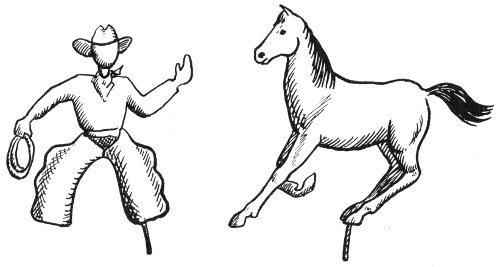
If the foreground figure does not stand higher than the cigar box is deep, it may be placed on the lid of the box, and the background material carefully located so that the lid will still close.

All ground has texture, whether it is a pine-needle blanketed slope or an asphalt pavement. The surface beneath our feet looks nothing at all as does a painted surface. So it is, that one of the most important points to remember in creating an illusion of reality and depth in a diorama, whether it is of cigar box or department store window size, is to create an appropriate foreground texture.
The balsa wood or styrofoam block you may have used in your foreground provides the main shape and bulk of that foreground. A good paper-mache mix can be made by mixing equal parts of Plaster-of-Paris, yellow dextrine, and powdered asbestos. The plaster and asbestos can be found in building supply stores, and the yellow dextrine at the chemical supply houses. Denver Fire Clay has the yellow dextrine in Denver. Put these three dry ingredients in a jar and shake them until they are well distributed. The mix can 7 be stored dry. To use, add water to the dry mix to the consistency of putty or a very thick paste, mixing just enough to use at one time. The mache will form a “skin” on the surface in about an hour, but can be pushed and modelled somewhat longer. It will dry to a rock-like hardness overnight. If you plan to build up much thickness, it is best to do it in several thin layers. Let each layer dry before adding the next. The mache mix is spread over the balsa wood or styrofoam block with the palette knife or flexible spatula, to a thickness of no more than ¹/₁₆″. If the mix sticks to the palette knife (or to your fingers), moisten the knife just a little, and the material will not stick.
The mache can be used to make a smooth joint between the foreground block that slopes up at the back and the picture background. Try to make this joint a smooth curve, not a sharp angle.
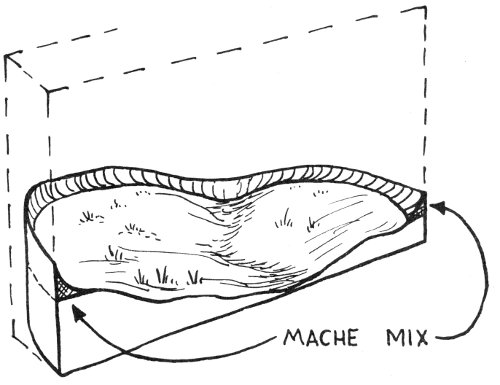
Cliff faces and large rocks, or formations such as those in a “moonscape”, can be carved from styrofoam chunks. The blocks or chunks are fastened together by using wooden toothpicks 8 and Elmer’s glue. The complete foreground is then covered with a layer of the paper mache mix to hide the obvious plastic texture. Again, Elmer’s glue is brushed on and the “rocks” are given a texture with fine sawdust or sand.

Another type of cliff face, with a carved cave opening (for bears, prehistoric cave dwellers, etc.) is made in the same way. In mounting, the background picture is curved on just one side and the carved cliff face occupies the full depth of the cigar box on the side opposite the curve.
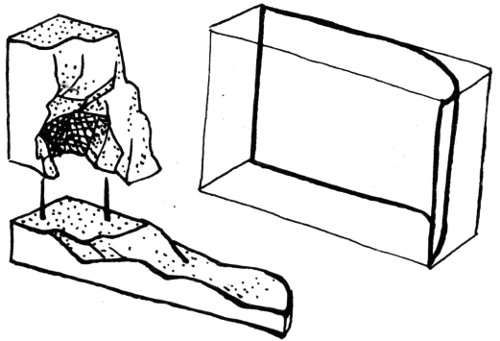
The same covering of mache, glue, and texture finishes this foreground.
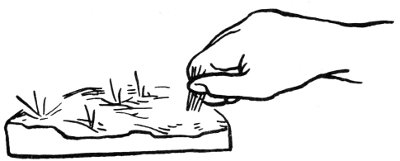
If grass-like “weeds” or plants are to be shown in the foreground they can be made of hemp rope cut and pushed into the wet mache mix. Dye the hemp green with “Rit” or “Tintex” before using. The adhesive quality of the mix will hold the strands securely. When the mache mix has dried to a rock hardness, the ground is painted with a thick coat of Elmer’s glue and sprinkled with a generous layer of varying textures and colors. Very fine sawdust already dyed a bright green is available at model railroad shops as model railroad “grass”. If you prefer a less brilliant color, you may dye sawdust with the Rit or Tintex.
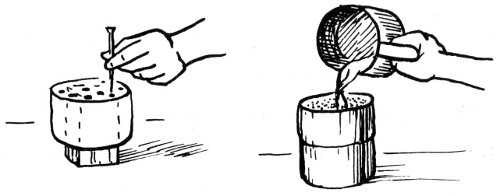
Take two one pound coffee cans. Punch holes in the bottom of one with a hammer and nail. Hold the coffee can against a scrap of 2″ × 4″ wood when you punch the holes. Set up the cans, the “sieve” on top. Fill the top can about half full of sawdust. Heat two or three cups of water to boiling point. Drop in dye tablet or powder and let it dissolve.
Pour hot dye over sawdust. The dye can be poured through the sawdust as many times as is necessary to get the depth of color desired. Spread wet sawdust out on newspapers to dry.
It is a good idea to dye several batches with different greens and browns, and to sift the dried sawdust through a piece of window screen, then a kitchen sieve, to get fine, medium and coarse grades. A different texture can be made by grinding up a ¼″ wooden dowel (available at hardware stores or lumber companies) in a clean pencil sharpener. When you glue the sawdust—or fine sand—or any other texture to the base, vary the color and the texture. Use some light green and some dark, and add a little brown or tan of a finer texture than the green, to resemble dirt showing through the grass. Gravel ranging from BB shot to garden pea size can be used for larger rocks. It is also a good idea to use coarse textures near the front of the box, fine textures at the rear, to approximate a correct textural perspective.
The most important thing to do in putting in this dirt and grass covering is to observe nature itself as closely as it is possible, seeing just how patches of vegetation grow—whether slopes are bare and what the “mosaic” of dirt and greenness is. The foreground will look natural only if it is based on observed knowledge of the actual relationships in nature.

can be made with the previously described hemp method and by using lichen from model railroad shops, dried weeds and 11 twigs, fern-like material (actually a kind of seaweed) usually sold at Christmas time by ten-cent stores, by using cut paper and any other material that appears appropriate. Sponges are not recommended. Somehow, they always resemble nothing but sponges.
Lichen can be torn into little clumps and fastened to the base with Elmer’s glue.
Dried weeds and twigs can be dipped in Elmer’s glue, then sprinkled with or dipped into the dyed sawdust to get a different texture in a bush. If you have cut tiny scraps of colored paper, these can be spotted on the lichen or dried weed bushes to resemble flowers. A toothpick will help to put just one drop of glue on the bush—and the same glue-dipped toothpick will then pick up the fleck of color to put it in place.
Unprinted newspaper (available in pads from art supply stores) can be used to make the spears at the base of a yucca tree. Cut a strip of unprinted newspaper. Slash it.

Roll up strip tightly and spread Elmer’s glue along bottom of strip as you roll. Bend outer layers down to make proper shape.

Prickly pear cactus can be made with pipe cleaners bent into correct outline, tied with thread, then the outlines filled in with the paper mache mix.

Ferns and palms are made by gluing a wire (get a spool of 22 or 23 gauge wire from a hardware store) between two lengths of gummed paper tape. Let wire extend beyond paper tape for length of stem or trunk plus the usual ½″ for pushing into the base.
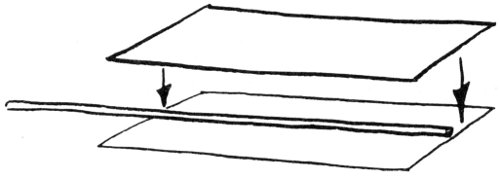
Bend paper over, trim, then slash. Make several, then twist wire “stems” together.
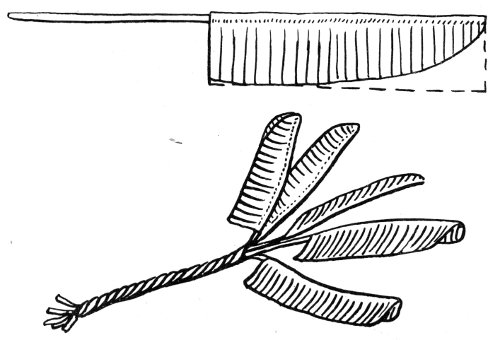
Paint fronds with poster color, water color, or latex white with casein colors.

If “fiddlenecks” are required, they can be made from pipe cleaners and twisted in with the wire stems of the fronds.

Wrap stems with ¼″ or ½″ strip of brown crepe paper cut across grain of package, and fastened with library paste or Elmer’s glue. Bend wire “fronds” into proper shape. Drill or punch hole in base. Smear base of tree and hole with Elmer’s glue, mount tree in place. Glue dirt or grass in place at base of tree.
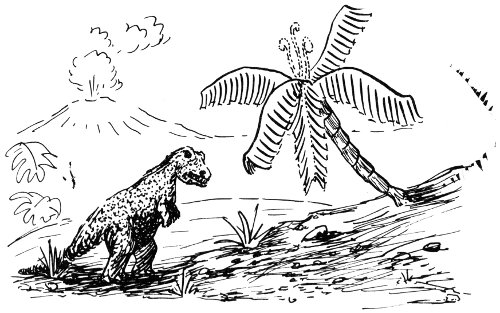
A quiet pond may be made with a mirror. Glue the mirror to the cigar box before installing anything else. Glue in the background picture next, then carve chunks of styrofoam for the remaining foreground. Slope “shores” down toward mirror “pond”. Let the edges of the styrofoam cover edges of mirror, making an irregular shape for the pond. Glue styrofoam in place with Elmer’s. For added realism, ripples may be added to the mirror surface, using clear varnish and oil paints. Mix a tiny bit of Prussian or “Thalo” blue with some clear varnish. Use just enough to tint the varnish. Flow varnish on surface of mirror, to a depth of about ¹/₃₂″. Before varnish is completely dry, use an empty “Flit” gun to pump air over the surface. This air will form ripples which, as the varnish dries, will remain on the surface. It may be necessary to repeat the air pumping a few times before the varnish surface hardens.

A stream can be made using broken glass and some Duco or Testor’s Airplane cement. The light blue glass from broken telephone line insulators, light blue Mexican glass or other glass of a light blue color may be used. Put the glass in a paper sack, then put that sack into two more sacks. Put the sacks on a solid surface and break the glass into small 15 pieces by hitting the sack with a hammer.
Make your foreground with styrofoam or balsa wood chunks, covering the material with the paper mache mix and working out (modelling) the stream bed with the mix. Let the mache harden before completing the stream. While the mix is still soft, push in weeds, cattails, any correct streamside plants, making them from hemp rope or from other previously described materials.
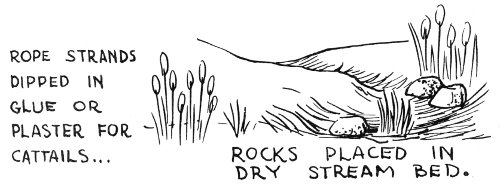
When the stream bed is hard, paint the bottom with a blue paint; lighten this blue color as you paint from the bottom toward the sides. Along the banks of the stream, paint in a light brown color. Let the paint dry completely. Squirt a small amount of Duco or Testor’s along the stream bottom; sprinkle pieces of glass thickly in glue before the glue sets. Push the glass into the glue to be sure it is well anchored. Squirt more cement over top of glass until top surface looks the same as a stream surface. Again, follow nature as closely as it is possible. Base your stream direction, flow, eddies, and riffles on observed knowledge. Mix a little talcum powder in some of the glue and stir quickly and hard to get a froth. Use this white, frothy material along the part of the stream surface that would be frothy. If you want the “water” to be breaking over boulders in the stream bed, place pea-size gravel pebbles in the stream bed at the same 16 time you place the glass fragments.
Another method for a stream uses aluminum foil and light blue cellophane. Using ordinary household aluminum foil, tear off enough to cover the bottom of your stream area. Crumple the foil tightly, then smooth it out and glue to the base with Duco, Testor’s, or Pliobond. Cut a piece of blue-green cellophane to fit over the foil. Crumple the cellophane tightly, then smooth out. Glue the cellophane to the foil with Duco or Testor’s.
Finish both of the above stream methods by painting Elmer’s glue along the banks and shore, covering the edge of the water area, then sprinkle with sand, sawdust, or other texture, and complete the vegetation as previously described.
Most of the methods used in making the cigar box exhibits can be used in preparing larger displays, but the immediate problem presented is that of the setting, since there are no standard size boxes of the correct proportions into which to put your foreground material. This is easily solved. Use Elmer’s glue and carpet tacks to fasten a piece of pebble-board, matt board, or poster board to two 1″ × 1½″ wooden supports.

PEBBLE BOARD 1½″ 1″
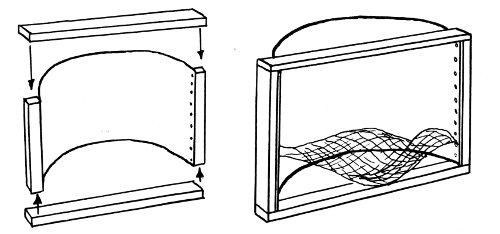
Nail on top and bottom wooden 1″ × 1½″ braces to give the curve to the background.
Poke, pull, and bend window screen to form main contours of base.
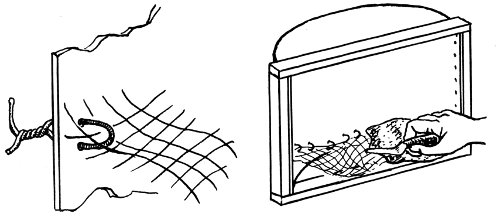
Drill pairs of holes around pebble-board background. Push hairpin shaped wire (stovepipe wire or finer) through screen, through holes, twist tightly in back with pliers.
Spread paper mache mix over window screen with palette knife or spatula. Dry tempera pigments may be mixed very sparingly with mache to give a basic ground color. Smooth joint between screen and background into a curve, not a sharp angle.

“Plant” hemp “bushes” in wet mache if desired.
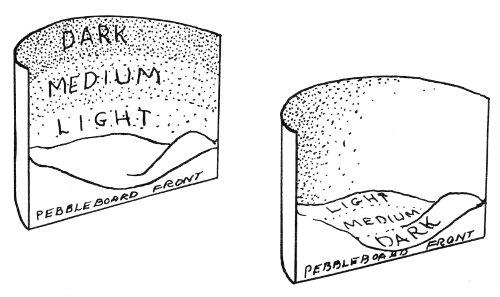
Mix three sky blues from Towne’s Gold Bond Latex Blue and a latex white. Paint dark at the top, blend medium in the middle, light at bottom, blending almost to white at the horizon. Use a soft 1″ brush. Do not be afraid to blend. Cut and glue a piece of pebble-board to fit between the bottom of contoured foreground and base. Use Elmer’s glue.
Mix three browns for ground color. Use burnt umber casein tube color with latex white. Paint dark at front of foreground, blend through medium to very light at the background. When paint dries, proceed as with cigar box, spreading foreground surface with a thick coat of Elmer’s glue, sprinkling on dyed sawdust, sand, gravel, etc. Bushes and shrubs are made the same way, with lichen, weeds, and other materials.
Autumn and winter trees are made from dried twigs and weeds. Leafed-out trees are made from clothesline wire and lichen. Twist wire into tree skeleton shape. See art books on “how to draw trees” for different tree skeletons and silhouettes. Cover wire trunk with paper mache mix and model to resemble bark. Tear off small clumps of lichen and glue to wire branches with Elmer’s glue. Drape some pieces over several branches.
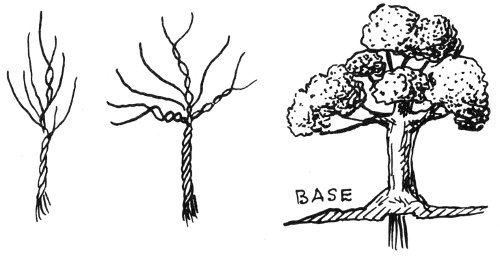
BASE
Drill hole in base, glue tree in place. Use paper mache to build up base of tree and to model exposed roots.
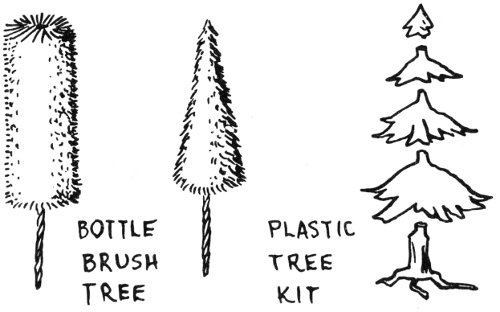
Small trees in the distance can be made by trimming bottle or test-tube brushes to the proper shape. Dip tree in green enamel paint, then sprinkle dyed sawdust on wet paint, or 20 shake paint-wet tree in jar with dyed sawdust. Use paper mache mix to build proper trunk texture. Medium size trees can be made from an excellent “Tree Kit” manufactured by Aurora Plastics Co., of West Hempstead, New York, and available at most model railroad shops. This kit contains graduated sections that are stacked together and glued. It will help to touch up and vary the color. Oil paints will stick to the plastic. These trees are glued to your base with Pliobond.
Large evergreens can be made from golden yarrow gathered in fall and winter. The stalks are dyed a deep green and permitted to dry.

Use Weldwood contact cement to glue a small diameter wire to under side of twig. Use tube to spread cement along twig. Hold wire with spring clothespin and run full length of wire into tube. Let cement dry for about 15 minutes, then press wire to under side of twig. Bend wire and stem into desired position. Use fine wire to fasten several twigs together into branches.
Using a wooden dowel at least ¼″ in diameter (get at hardware store up to 3′ long), drill small holes through from different angles. Then, by whittling or sanding, taper the dowel. Poke wire-wrapped branch ends into holes. Anchor 21 with Pliobond. Let dry, then trim excess branch lengths from opposite side of trunk. Use paper mache mix to cover wooden dowel, shape and thicken branches and trunk, and model branch joints. Paint the paper mache with water colors, poster colors, or latex white with casein temperas.
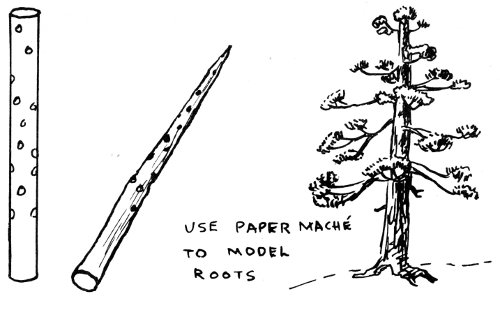
USE PAPER MACHE TO MODEL ROOTS
is made by spraying a wisp of cotton with clear Krylon. This clear plastic in a spray can is obtained from nearly any art supply house and at most hardware stores. Draw out the cotton into a smoke-shaped wisp. Spray gently with the Krylon to set shape, then spray again to strengthen. The cotton may be drawn out even more after the Krylon has set.
can be indicated by using styrofoam and not coating it with the paper mache mix. A finer textured snow is made by spraying the Christmas spray-can “snow” over the modelled paper mache base, and adding sparkle by glueing specks of salt in place. The spray-can snow is a good material to use in putting snow on tree branches.
One last minute tip ... when you use a brush with the Tri-Tix rubber cement, soap the bristles thoroughly before using. Get the brush wet, then scrub up a good lather with Ivory or similar bar soap; squeeze most of the lather out of the brush, but do not wash it out. Then, in its lathered state, use the brush with the Tri-Tix. Wash it out immediately after use. The soap remaining in the brush during the glueing process will make the brush easy to clean.
Remember always, that it is not necessary for a person to have trained artistic ability to produce interesting exhibits. Imagination and the ability to try something new are the only requirements. Materials can be found, sometimes, in most unlikely spots ... aquarium supply stores, novelty shops. Once one has become conscious of the possibilities, miniature things leap into view from the store shelves, and whole forests of trees can be seen in a weed.
CIGAR BOX DIORAMAS
These little displays can be used in many ways. They are simple enough that a child can make them, effective enough to stimulate interest in the subject portrayed. They can be made by the teacher and used to spark interest in new units or made by the students as projects for the unit. They are useful as follow-up projects after a field trip to a museum, industry, or other place of interest.
One need not be an artist to create interesting and acceptable displays. There are many items available from novelty stores, souvenir counters, or ten-cent stores, which can be adapted to use in the cigar boxes. Pictures clipped from magazines can be used for backgrounds, as can the large picture post-cards now found nearly everywhere.
The person who exercises imagination, seeing space ships in plastic hair curlers and rocket ships in metal pencil protectors, will enjoy making the exhibits and will be able to share the creative experience with others.
ARMINTA NEAL
4960 W. Oregon Place
Denver 19, Colorado
End of the Project Gutenberg EBook of Cigar-Box Dioramas, by Arminta Neal
*** END OF THIS PROJECT GUTENBERG EBOOK CIGAR-BOX DIORAMAS ***
***** This file should be named 57148-h.htm or 57148-h.zip *****
This and all associated files of various formats will be found in:
http://www.gutenberg.org/5/7/1/4/57148/
Produced by Stephen Hutcheson and the Online Distributed
Proofreading Team at http://www.pgdp.net
Updated editions will replace the previous one--the old editions will
be renamed.
Creating the works from print editions not protected by U.S. copyright
law means that no one owns a United States copyright in these works,
so the Foundation (and you!) can copy and distribute it in the United
States without permission and without paying copyright
royalties. Special rules, set forth in the General Terms of Use part
of this license, apply to copying and distributing Project
Gutenberg-tm electronic works to protect the PROJECT GUTENBERG-tm
concept and trademark. Project Gutenberg is a registered trademark,
and may not be used if you charge for the eBooks, unless you receive
specific permission. If you do not charge anything for copies of this
eBook, complying with the rules is very easy. You may use this eBook
for nearly any purpose such as creation of derivative works, reports,
performances and research. They may be modified and printed and given
away--you may do practically ANYTHING in the United States with eBooks
not protected by U.S. copyright law. Redistribution is subject to the
trademark license, especially commercial redistribution.
START: FULL LICENSE
THE FULL PROJECT GUTENBERG LICENSE
PLEASE READ THIS BEFORE YOU DISTRIBUTE OR USE THIS WORK
To protect the Project Gutenberg-tm mission of promoting the free
distribution of electronic works, by using or distributing this work
(or any other work associated in any way with the phrase "Project
Gutenberg"), you agree to comply with all the terms of the Full
Project Gutenberg-tm License available with this file or online at
www.gutenberg.org/license.
Section 1. General Terms of Use and Redistributing Project
Gutenberg-tm electronic works
1.A. By reading or using any part of this Project Gutenberg-tm
electronic work, you indicate that you have read, understand, agree to
and accept all the terms of this license and intellectual property
(trademark/copyright) agreement. If you do not agree to abide by all
the terms of this agreement, you must cease using and return or
destroy all copies of Project Gutenberg-tm electronic works in your
possession. If you paid a fee for obtaining a copy of or access to a
Project Gutenberg-tm electronic work and you do not agree to be bound
by the terms of this agreement, you may obtain a refund from the
person or entity to whom you paid the fee as set forth in paragraph
1.E.8.
1.B. "Project Gutenberg" is a registered trademark. It may only be
used on or associated in any way with an electronic work by people who
agree to be bound by the terms of this agreement. There are a few
things that you can do with most Project Gutenberg-tm electronic works
even without complying with the full terms of this agreement. See
paragraph 1.C below. There are a lot of things you can do with Project
Gutenberg-tm electronic works if you follow the terms of this
agreement and help preserve free future access to Project Gutenberg-tm
electronic works. See paragraph 1.E below.
1.C. The Project Gutenberg Literary Archive Foundation ("the
Foundation" or PGLAF), owns a compilation copyright in the collection
of Project Gutenberg-tm electronic works. Nearly all the individual
works in the collection are in the public domain in the United
States. If an individual work is unprotected by copyright law in the
United States and you are located in the United States, we do not
claim a right to prevent you from copying, distributing, performing,
displaying or creating derivative works based on the work as long as
all references to Project Gutenberg are removed. Of course, we hope
that you will support the Project Gutenberg-tm mission of promoting
free access to electronic works by freely sharing Project Gutenberg-tm
works in compliance with the terms of this agreement for keeping the
Project Gutenberg-tm name associated with the work. You can easily
comply with the terms of this agreement by keeping this work in the
same format with its attached full Project Gutenberg-tm License when
you share it without charge with others.
1.D. The copyright laws of the place where you are located also govern
what you can do with this work. Copyright laws in most countries are
in a constant state of change. If you are outside the United States,
check the laws of your country in addition to the terms of this
agreement before downloading, copying, displaying, performing,
distributing or creating derivative works based on this work or any
other Project Gutenberg-tm work. The Foundation makes no
representations concerning the copyright status of any work in any
country outside the United States.
1.E. Unless you have removed all references to Project Gutenberg:
1.E.1. The following sentence, with active links to, or other
immediate access to, the full Project Gutenberg-tm License must appear
prominently whenever any copy of a Project Gutenberg-tm work (any work
on which the phrase "Project Gutenberg" appears, or with which the
phrase "Project Gutenberg" is associated) is accessed, displayed,
performed, viewed, copied or distributed:
This eBook is for the use of anyone anywhere in the United States and
most other parts of the world at no cost and with almost no
restrictions whatsoever. You may copy it, give it away or re-use it
under the terms of the Project Gutenberg License included with this
eBook or online at www.gutenberg.org. If you are not located in the
United States, you'll have to check the laws of the country where you
are located before using this ebook.
1.E.2. If an individual Project Gutenberg-tm electronic work is
derived from texts not protected by U.S. copyright law (does not
contain a notice indicating that it is posted with permission of the
copyright holder), the work can be copied and distributed to anyone in
the United States without paying any fees or charges. If you are
redistributing or providing access to a work with the phrase "Project
Gutenberg" associated with or appearing on the work, you must comply
either with the requirements of paragraphs 1.E.1 through 1.E.7 or
obtain permission for the use of the work and the Project Gutenberg-tm
trademark as set forth in paragraphs 1.E.8 or 1.E.9.
1.E.3. If an individual Project Gutenberg-tm electronic work is posted
with the permission of the copyright holder, your use and distribution
must comply with both paragraphs 1.E.1 through 1.E.7 and any
additional terms imposed by the copyright holder. Additional terms
will be linked to the Project Gutenberg-tm License for all works
posted with the permission of the copyright holder found at the
beginning of this work.
1.E.4. Do not unlink or detach or remove the full Project Gutenberg-tm
License terms from this work, or any files containing a part of this
work or any other work associated with Project Gutenberg-tm.
1.E.5. Do not copy, display, perform, distribute or redistribute this
electronic work, or any part of this electronic work, without
prominently displaying the sentence set forth in paragraph 1.E.1 with
active links or immediate access to the full terms of the Project
Gutenberg-tm License.
1.E.6. You may convert to and distribute this work in any binary,
compressed, marked up, nonproprietary or proprietary form, including
any word processing or hypertext form. However, if you provide access
to or distribute copies of a Project Gutenberg-tm work in a format
other than "Plain Vanilla ASCII" or other format used in the official
version posted on the official Project Gutenberg-tm web site
(www.gutenberg.org), you must, at no additional cost, fee or expense
to the user, provide a copy, a means of exporting a copy, or a means
of obtaining a copy upon request, of the work in its original "Plain
Vanilla ASCII" or other form. Any alternate format must include the
full Project Gutenberg-tm License as specified in paragraph 1.E.1.
1.E.7. Do not charge a fee for access to, viewing, displaying,
performing, copying or distributing any Project Gutenberg-tm works
unless you comply with paragraph 1.E.8 or 1.E.9.
1.E.8. You may charge a reasonable fee for copies of or providing
access to or distributing Project Gutenberg-tm electronic works
provided that
* You pay a royalty fee of 20% of the gross profits you derive from
the use of Project Gutenberg-tm works calculated using the method
you already use to calculate your applicable taxes. The fee is owed
to the owner of the Project Gutenberg-tm trademark, but he has
agreed to donate royalties under this paragraph to the Project
Gutenberg Literary Archive Foundation. Royalty payments must be paid
within 60 days following each date on which you prepare (or are
legally required to prepare) your periodic tax returns. Royalty
payments should be clearly marked as such and sent to the Project
Gutenberg Literary Archive Foundation at the address specified in
Section 4, "Information about donations to the Project Gutenberg
Literary Archive Foundation."
* You provide a full refund of any money paid by a user who notifies
you in writing (or by e-mail) within 30 days of receipt that s/he
does not agree to the terms of the full Project Gutenberg-tm
License. You must require such a user to return or destroy all
copies of the works possessed in a physical medium and discontinue
all use of and all access to other copies of Project Gutenberg-tm
works.
* You provide, in accordance with paragraph 1.F.3, a full refund of
any money paid for a work or a replacement copy, if a defect in the
electronic work is discovered and reported to you within 90 days of
receipt of the work.
* You comply with all other terms of this agreement for free
distribution of Project Gutenberg-tm works.
1.E.9. If you wish to charge a fee or distribute a Project
Gutenberg-tm electronic work or group of works on different terms than
are set forth in this agreement, you must obtain permission in writing
from both the Project Gutenberg Literary Archive Foundation and The
Project Gutenberg Trademark LLC, the owner of the Project Gutenberg-tm
trademark. Contact the Foundation as set forth in Section 3 below.
1.F.
1.F.1. Project Gutenberg volunteers and employees expend considerable
effort to identify, do copyright research on, transcribe and proofread
works not protected by U.S. copyright law in creating the Project
Gutenberg-tm collection. Despite these efforts, Project Gutenberg-tm
electronic works, and the medium on which they may be stored, may
contain "Defects," such as, but not limited to, incomplete, inaccurate
or corrupt data, transcription errors, a copyright or other
intellectual property infringement, a defective or damaged disk or
other medium, a computer virus, or computer codes that damage or
cannot be read by your equipment.
1.F.2. LIMITED WARRANTY, DISCLAIMER OF DAMAGES - Except for the "Right
of Replacement or Refund" described in paragraph 1.F.3, the Project
Gutenberg Literary Archive Foundation, the owner of the Project
Gutenberg-tm trademark, and any other party distributing a Project
Gutenberg-tm electronic work under this agreement, disclaim all
liability to you for damages, costs and expenses, including legal
fees. YOU AGREE THAT YOU HAVE NO REMEDIES FOR NEGLIGENCE, STRICT
LIABILITY, BREACH OF WARRANTY OR BREACH OF CONTRACT EXCEPT THOSE
PROVIDED IN PARAGRAPH 1.F.3. YOU AGREE THAT THE FOUNDATION, THE
TRADEMARK OWNER, AND ANY DISTRIBUTOR UNDER THIS AGREEMENT WILL NOT BE
LIABLE TO YOU FOR ACTUAL, DIRECT, INDIRECT, CONSEQUENTIAL, PUNITIVE OR
INCIDENTAL DAMAGES EVEN IF YOU GIVE NOTICE OF THE POSSIBILITY OF SUCH
DAMAGE.
1.F.3. LIMITED RIGHT OF REPLACEMENT OR REFUND - If you discover a
defect in this electronic work within 90 days of receiving it, you can
receive a refund of the money (if any) you paid for it by sending a
written explanation to the person you received the work from. If you
received the work on a physical medium, you must return the medium
with your written explanation. The person or entity that provided you
with the defective work may elect to provide a replacement copy in
lieu of a refund. If you received the work electronically, the person
or entity providing it to you may choose to give you a second
opportunity to receive the work electronically in lieu of a refund. If
the second copy is also defective, you may demand a refund in writing
without further opportunities to fix the problem.
1.F.4. Except for the limited right of replacement or refund set forth
in paragraph 1.F.3, this work is provided to you 'AS-IS', WITH NO
OTHER WARRANTIES OF ANY KIND, EXPRESS OR IMPLIED, INCLUDING BUT NOT
LIMITED TO WARRANTIES OF MERCHANTABILITY OR FITNESS FOR ANY PURPOSE.
1.F.5. Some states do not allow disclaimers of certain implied
warranties or the exclusion or limitation of certain types of
damages. If any disclaimer or limitation set forth in this agreement
violates the law of the state applicable to this agreement, the
agreement shall be interpreted to make the maximum disclaimer or
limitation permitted by the applicable state law. The invalidity or
unenforceability of any provision of this agreement shall not void the
remaining provisions.
1.F.6. INDEMNITY - You agree to indemnify and hold the Foundation, the
trademark owner, any agent or employee of the Foundation, anyone
providing copies of Project Gutenberg-tm electronic works in
accordance with this agreement, and any volunteers associated with the
production, promotion and distribution of Project Gutenberg-tm
electronic works, harmless from all liability, costs and expenses,
including legal fees, that arise directly or indirectly from any of
the following which you do or cause to occur: (a) distribution of this
or any Project Gutenberg-tm work, (b) alteration, modification, or
additions or deletions to any Project Gutenberg-tm work, and (c) any
Defect you cause.
Section 2. Information about the Mission of Project Gutenberg-tm
Project Gutenberg-tm is synonymous with the free distribution of
electronic works in formats readable by the widest variety of
computers including obsolete, old, middle-aged and new computers. It
exists because of the efforts of hundreds of volunteers and donations
from people in all walks of life.
Volunteers and financial support to provide volunteers with the
assistance they need are critical to reaching Project Gutenberg-tm's
goals and ensuring that the Project Gutenberg-tm collection will
remain freely available for generations to come. In 2001, the Project
Gutenberg Literary Archive Foundation was created to provide a secure
and permanent future for Project Gutenberg-tm and future
generations. To learn more about the Project Gutenberg Literary
Archive Foundation and how your efforts and donations can help, see
Sections 3 and 4 and the Foundation information page at
www.gutenberg.org
Section 3. Information about the Project Gutenberg Literary Archive Foundation
The Project Gutenberg Literary Archive Foundation is a non profit
501(c)(3) educational corporation organized under the laws of the
state of Mississippi and granted tax exempt status by the Internal
Revenue Service. The Foundation's EIN or federal tax identification
number is 64-6221541. Contributions to the Project Gutenberg Literary
Archive Foundation are tax deductible to the full extent permitted by
U.S. federal laws and your state's laws.
The Foundation's principal office is in Fairbanks, Alaska, with the
mailing address: PO Box 750175, Fairbanks, AK 99775, but its
volunteers and employees are scattered throughout numerous
locations. Its business office is located at 809 North 1500 West, Salt
Lake City, UT 84116, (801) 596-1887. Email contact links and up to
date contact information can be found at the Foundation's web site and
official page at www.gutenberg.org/contact
For additional contact information:
Dr. Gregory B. Newby
Chief Executive and Director
gbnewby@pglaf.org
Section 4. Information about Donations to the Project Gutenberg
Literary Archive Foundation
Project Gutenberg-tm depends upon and cannot survive without wide
spread public support and donations to carry out its mission of
increasing the number of public domain and licensed works that can be
freely distributed in machine readable form accessible by the widest
array of equipment including outdated equipment. Many small donations
($1 to $5,000) are particularly important to maintaining tax exempt
status with the IRS.
The Foundation is committed to complying with the laws regulating
charities and charitable donations in all 50 states of the United
States. Compliance requirements are not uniform and it takes a
considerable effort, much paperwork and many fees to meet and keep up
with these requirements. We do not solicit donations in locations
where we have not received written confirmation of compliance. To SEND
DONATIONS or determine the status of compliance for any particular
state visit www.gutenberg.org/donate
While we cannot and do not solicit contributions from states where we
have not met the solicitation requirements, we know of no prohibition
against accepting unsolicited donations from donors in such states who
approach us with offers to donate.
International donations are gratefully accepted, but we cannot make
any statements concerning tax treatment of donations received from
outside the United States. U.S. laws alone swamp our small staff.
Please check the Project Gutenberg Web pages for current donation
methods and addresses. Donations are accepted in a number of other
ways including checks, online payments and credit card donations. To
donate, please visit: www.gutenberg.org/donate
Section 5. General Information About Project Gutenberg-tm electronic works.
Professor Michael S. Hart was the originator of the Project
Gutenberg-tm concept of a library of electronic works that could be
freely shared with anyone. For forty years, he produced and
distributed Project Gutenberg-tm eBooks with only a loose network of
volunteer support.
Project Gutenberg-tm eBooks are often created from several printed
editions, all of which are confirmed as not protected by copyright in
the U.S. unless a copyright notice is included. Thus, we do not
necessarily keep eBooks in compliance with any particular paper
edition.
Most people start at our Web site which has the main PG search
facility: www.gutenberg.org
This Web site includes information about Project Gutenberg-tm,
including how to make donations to the Project Gutenberg Literary
Archive Foundation, how to help produce our new eBooks, and how to
subscribe to our email newsletter to hear about new eBooks.